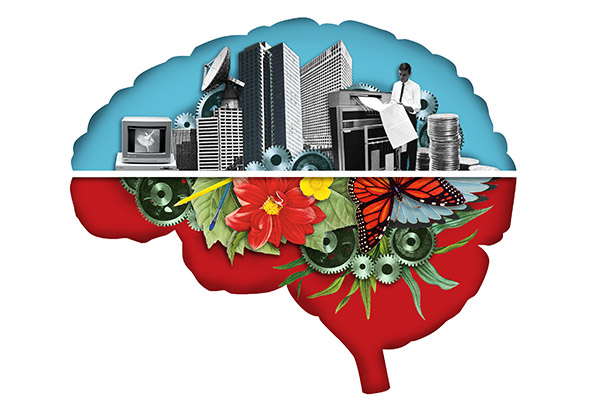A New Personality Test: What Your Brain Says About You
A leading psychologist says the left-brain/right-brain theory is bunk—and that there's a smarter place to draw the line.

Illustration: Ciara Phelan
Odds are at some point in your life you've been labeled right-brained (creative and thoughtful) or left-brained (detail-oriented and logical), but Stephen Kosslyn, PhD, coauthor of the new book Top Brain, Bottom Brain, says those classifications are all wrong. Kosslyn believes a more likely personality split happens across the middle, dividing us into top-brain and bottom-brain users. To find out why, we picked his brain.
Q: Why is the old left vs. right theory flawed?
A: None of the sweeping claims about it are supported by solid science. In practically any brain-imaging study, you're going to see activation in both hemispheres. The two are different, in very precise ways, but the broad generalizations people have been encouraged to believe about them aren't true.
Q: How did you arrive at the top brain/bottom brain theory?
A: When you look at a brain, you immediately see the left and right sides, but you can also perceive the top and bottom, distinguished primarily by a big crease. My team analyzed a tremendous amount of research and found that the top is exclusively involved in creating and monitoring plans. The bottom, meanwhile, classifies and interprets information. But the striking thing we discovered is that people who made high use of the top brain could use the bottom brain minimally, a lot, or at some level in between. And this could happen vice versa.
Q: Could you be falling into the same trap as the right/left brain camp?
A: The one thing I didn't want to do was make the same mistake others did! Each part of the brain influences and interacts with the other. So I came up with four modes of thinking—mover, stimulator, perceiver, and adaptor—that emerged from the interactions I saw between the top and the bottom brain that go beyond basic function. People who tend to operate in stimulator mode make extra use of the top brain; perceivers make extra use of the bottom brain; movers make strong use of both top and bottom; and adaptors don't utilize either in any additional capacity—instead they let external circumstances guide their actions.
Q: What makes this better than other ways of evaluating personality?
A: In one study, we compared our findings with those from four widely used cognitive and personality tests that measure things like aptitude, extraversion, mental imagery, and social skills. We found that these tests were able to account for some strengths of top-brain thinking such as the ability to formulate strategies, but they didn't measure traits that are strong in bottom-brain thinking, like being perceptive.
Q: So will this breakdown help someone figure out how to play to her strengths?
A: Absolutely. And the results may be especially useful when it comes to working on any kind of team. In general, if your group includes people who fall into each of the four categories, they'll each offer something different that, when put together, can lead to great success.
Next: What type of thinker are you?
Q: Why is the old left vs. right theory flawed?
A: None of the sweeping claims about it are supported by solid science. In practically any brain-imaging study, you're going to see activation in both hemispheres. The two are different, in very precise ways, but the broad generalizations people have been encouraged to believe about them aren't true.
Q: How did you arrive at the top brain/bottom brain theory?
A: When you look at a brain, you immediately see the left and right sides, but you can also perceive the top and bottom, distinguished primarily by a big crease. My team analyzed a tremendous amount of research and found that the top is exclusively involved in creating and monitoring plans. The bottom, meanwhile, classifies and interprets information. But the striking thing we discovered is that people who made high use of the top brain could use the bottom brain minimally, a lot, or at some level in between. And this could happen vice versa.
Q: Could you be falling into the same trap as the right/left brain camp?
A: The one thing I didn't want to do was make the same mistake others did! Each part of the brain influences and interacts with the other. So I came up with four modes of thinking—mover, stimulator, perceiver, and adaptor—that emerged from the interactions I saw between the top and the bottom brain that go beyond basic function. People who tend to operate in stimulator mode make extra use of the top brain; perceivers make extra use of the bottom brain; movers make strong use of both top and bottom; and adaptors don't utilize either in any additional capacity—instead they let external circumstances guide their actions.
Q: What makes this better than other ways of evaluating personality?
A: In one study, we compared our findings with those from four widely used cognitive and personality tests that measure things like aptitude, extraversion, mental imagery, and social skills. We found that these tests were able to account for some strengths of top-brain thinking such as the ability to formulate strategies, but they didn't measure traits that are strong in bottom-brain thinking, like being perceptive.
Q: So will this breakdown help someone figure out how to play to her strengths?
A: Absolutely. And the results may be especially useful when it comes to working on any kind of team. In general, if your group includes people who fall into each of the four categories, they'll each offer something different that, when put together, can lead to great success.
Next: What type of thinker are you?



